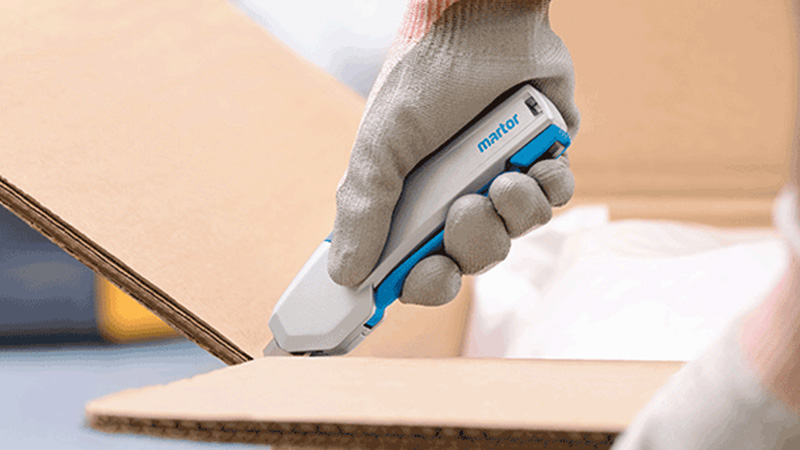
Accidents happens suddenly, especially when you are trying to "quickly" open a box with a knife. Ordinary knives can cause serious injuries on contact with the skin.
Discover all our safety knives
What is a safety knife and why is it important?
A safety knife differs from a traditional knife in that it is designed to avoid contact with the skin. This substantially reduces the risk of cuts. Safety knives have special mechanisms that shield the blade.
You can select the most suitable safety knife using the criteria below.
1. The material to be cut
The main selection criterion for a knife is the material that is to be cut. Film, paper and cardboard all require a different blade and holder than, for example, a strap cutter.
- Film cutters: for cutting film, plastic, packaging tape
- Cardboard cutters: for opening packs and packaging material
- Paper cutters
- Strap cutters
There are also ceramic safety knives or, in other words, finger-friendly safety knives. The double-sided ceramic knife is specially designed to stay sharper and cause fewer accidents. They are sharp enough to cut through all sorts of packaging materials but pose a lower risk in terms of cutting the skin.

2. Knife mechanism
At Vandeputte, we categorise safety knives according to three safety levels:
- Level 1: knives with manual retraction by means of a thumb-operated slider

- Level 2: knives with semi-automatic retraction where the blade retracts automatically if the slider is released

- Level 3: knives that retract fully automatically where the blade disappears after each cut, once the contact with the cut surface is lost

You also have knives with an embedded blade where the blade is fully laminated and you can never cut your fingers.

Be sure to read our article "How can I avoid cuts?". Here, we go into more depth about the different safety levels.
3. Metal detection
For sectors such as the food industry and laboratories, metal-detectable knives are essential. They have stainless steel blades and are made of blue plastic that is made using materials that can be detected by a metal detector. This allows the pieces to be detected if some of the plastic were to enter the food.

4. Replacing blades
TÜV-approved safety blades should always be safe and easy to replace. Some models require tools to change the blade, while other systems allow tool-free replacement.
It is also important to collect and dispose of used blades safely. Discover our different types of collection boxes for cutting tools and replacement knives.
5. Suitable for right and left-handers
Most safety knives are available for left and right-handed users. Some models are universal and can be used by both groups.
6. Type of tool
Besides safety knives, other safe cutting tools include safety shears and window hammers. Consider which type of cutting tool best suits your specific application.
Safety knives at Vandeputte
Our range of safety knives is designed with ergonomics and safety as a priority. All knives meet strict safety standards and offer:
- Automatic protection when the blade is not in use
- Safe and sturdy blades that are easy to replace
- Knife holders that are designed to be safe even when set aside

